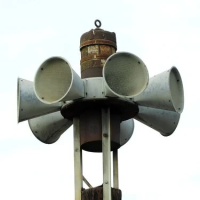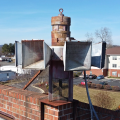STL-10: Difference between revisions
No edit summary |
ArxCyberwolf (talk | contribs) m (→History) |
||
| (33 intermediate revisions by 11 users not shown) | |||
| Line 1: | Line 1: | ||
{{Infobox siren | {{Infobox siren|title=Model STL-10|image=Model STL-10.png|caption=A Model STL-10 in French Camp, CA. Photo taken by CaliSirens00.|company=<div>[[Federal Signal Corporation|Federal Enterprises]] | ||
|title = | <div>[[Federal Signal Corporation|Federal Sign & Signal]] | ||
<div>[[Federal Signal Corporation|Federal Signal]]|produced=1953-1995|type=[[Omnidirectional]] [[Electromechanical]]|output=114 dB @ 100 ft|hz=50/60|hp=7.5-10 hp|voltage=208-240/480|current=AC 1 or 3 ph|preceded=<div>[[Federal Electric Fedelcode]] | |||
| | <div>[[Federal Signal Model 5]]|succeeded=[[Federal Signal Model ECLIPSE]]|manual=https://drive.google.com/file/d/1wz2Vk4vd9mgvjS9ioooqsj3vor7PWpfk/view?usp=sharing}}The '''STL-10''' ('''S'''ingle '''T'''one '''L'''ow, '''10''' Horsepower) is an omnidirectional vertical siren that was produced by Federal Signal during the mid to late 20th century which found popularity as both a fire siren and a civil defense siren. | ||
|produced = | |||
|type = [[Electromechanical]] | |||
|output = 114 | |||
| | |||
| | |||
| | |||
| | |||
|succeeded = | |||
|manual = | |||
}} | |||
The | == History == | ||
The STL-10 was introduced in 1953 by Federal Enterprises as an alternative to Federal Signal's popular [[Federal Signal STH-10|STH-10]], [[XT22|2T22]], and 3T22 sirens. Its low tone made it very distinct from other sirens and contributed to its high range of audibility. The low pitch made it more effective at a distance, as its tone carries further than sirens with a higher pitch. | |||
The STL-10 and its high tone counterpart the STH-10 were mainly sold as fire sirens. While they could also used for civil defense purposes, their main purpose was to alert volunteer firefighters to report to the fire station. The STL-10 was especially suitable in urban areas, where higher pitched sirens may be blocked out by traffic noise and obstructions such as tall buildings. The STL-10 saw most of its success in large cities such as New York and San Francisco, where its unmistakable piercing low sound was distinctly heard over the noise of traffic at great distances. | |||
The STL-10 was nowhere as popular as the STH-10, and as a result, they are harder to find than STH-10s today. Due to waning sales compared to the STH-10 as the use of fire sirens diminished with the rise of pagers, the STL-10 was discontinued in 1995, while the STH-10 continued to be sold until 2005. Both were effectively replaced by the [[Federal Signal Model ECLIPSE|ECLIPSE<sup>8</sup>]] in Federal Signal's lineup, as it has battery backup capabilities and improved performance while operating at a similar pitch to the STL-10. | |||
== Design == | |||
The STL-10 at its core sports a 20.5" 7-port rotor and stator, with a bare 1 or 3 phase 208-240/480 V induction motor above the rotor/stator assembly which has an eyebolt attached for ease of mounting and which lacks shielding from the elements. | |||
7 rounded sheet metal horns are attached to each stator port to project the sound directly from the rotor. Mesh screens are included on each horn to protect the rotor from debris. A cylindrical intake is located below the siren in between the siren's 3 included mounting legs. The STL-10 boasts a decibel rating of 114 dB at 100 ft. | |||
== Gallery == | |||
<gallery> | |||
File:STL-10 Rotor.jpg|A privately owned STL-10 with the intake removed, showing the rotor with its 7 long vanes. | |||
File:Square horned STL-10.png|An STL-10 with square horns in Warrenton, VA. Photo credit to Ben Schumin. | |||
</gallery> | |||
[[Category:Sirens]][[Category:Single Toned Sirens]][[Category:Electromechanical Sirens]][[Category:Omnidirectional Sirens]][[Category:Federal Signal Corporation]] | [[Category:Sirens]][[Category:Single Toned Sirens]][[Category:Electromechanical Sirens]][[Category:Omnidirectional Sirens]][[Category:Federal Signal Corporation]] | ||
__INDEX__ | |||
Latest revision as of 05:25, 11 January 2025
| Model STL-10 | |
 A Model STL-10 in French Camp, CA. Photo taken by CaliSirens00. | |
| Company | |
|---|---|
| Produced | 1953-1995 |
| Type | Omnidirectional Electromechanical |
| Sound output | 114 dB @ 100 ft |
| Frequency | 50/60 Hz |
| Horsepower | 7.5-10 hp |
| Voltage | 208-240/480 V AC 1 or 3 ph |
| Preceded by | |
| Succeeded by | Federal Signal Model ECLIPSE |
| Documentation | Manual |
The STL-10 (Single Tone Low, 10 Horsepower) is an omnidirectional vertical siren that was produced by Federal Signal during the mid to late 20th century which found popularity as both a fire siren and a civil defense siren.
History
The STL-10 was introduced in 1953 by Federal Enterprises as an alternative to Federal Signal's popular STH-10, 2T22, and 3T22 sirens. Its low tone made it very distinct from other sirens and contributed to its high range of audibility. The low pitch made it more effective at a distance, as its tone carries further than sirens with a higher pitch.
The STL-10 and its high tone counterpart the STH-10 were mainly sold as fire sirens. While they could also used for civil defense purposes, their main purpose was to alert volunteer firefighters to report to the fire station. The STL-10 was especially suitable in urban areas, where higher pitched sirens may be blocked out by traffic noise and obstructions such as tall buildings. The STL-10 saw most of its success in large cities such as New York and San Francisco, where its unmistakable piercing low sound was distinctly heard over the noise of traffic at great distances.
The STL-10 was nowhere as popular as the STH-10, and as a result, they are harder to find than STH-10s today. Due to waning sales compared to the STH-10 as the use of fire sirens diminished with the rise of pagers, the STL-10 was discontinued in 1995, while the STH-10 continued to be sold until 2005. Both were effectively replaced by the ECLIPSE8 in Federal Signal's lineup, as it has battery backup capabilities and improved performance while operating at a similar pitch to the STL-10.
Design
The STL-10 at its core sports a 20.5" 7-port rotor and stator, with a bare 1 or 3 phase 208-240/480 V induction motor above the rotor/stator assembly which has an eyebolt attached for ease of mounting and which lacks shielding from the elements.
7 rounded sheet metal horns are attached to each stator port to project the sound directly from the rotor. Mesh screens are included on each horn to protect the rotor from debris. A cylindrical intake is located below the siren in between the siren's 3 included mounting legs. The STL-10 boasts a decibel rating of 114 dB at 100 ft.
Gallery
-
A privately owned STL-10 with the intake removed, showing the rotor with its 7 long vanes.
-
An STL-10 with square horns in Warrenton, VA. Photo credit to Ben Schumin.

